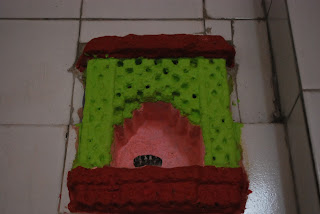Banganga Parikrama
Once upon a time the
denizens of Bombay depended on tanks and wells for their daily requirement of
water. The advent of piped water from Vihar and Tulsi lakes changed that and rendered
the tanks redundant, but Banganga, one of the ten tanks, still survives and is
today an iconic water body, drawing exceptionally curious tourists and gawkers.
The origin of Banganga is shrouded in mythology and the popular folklore is
that Lakshmana shot an arrow and brought the River Ganges to quench his elder
brother’s thirst, while they were camping here. Another myth suggests that this
land was reclaimed from sea by the Sage Parashurama. But a more pertinent point
of historical interest is that the precinct of Banganga is the oldest
continuously inhabited quarter of Bombay.
The access to Banganga is
through the cross lane that branches off from Walkeshwar Road and then down the
flight of steps through the Jabreshwar Galli, so named because it was acquired
forcibly (jabardasti) ; an apocryphal but amusing anecdote narrated by our
enthusiastic guide. But before the water tank can be espied, there is the
Jabreshwar temple with its arresting Nagara style Shikhar. The first sighting
of Banganga can be breathtaking depending on the time of the day, but the dark
green water is a clear sign of eutrophication; nevertheless it makes for pretty
pictures. Flights of steps lead down to the rectangular tank through all four
sides. Pairs of tall brick and mortar deepastambhas (lampposts) mark out the
several doorways to the steps leading down to the water. The geometry of steps is
a visual delight for photo buffs. The sun was low on the horizon and cast long
shadows over the green water.
All around scores of
skyscrapers soar skywards and catch the sunlight. Below in the shadow, around
the periphery of the tank, men and women go about their errands at a distinctly
unhurried pace. The contrast between the two worlds is too stark not to be
noticed. Fat ducks glide about lazily in the water, while young men sit on the
steps and gaze. Time seems to stand still at Banganga
Banganga is a very lived-in
place and hence not particularly tidy and clean. Numerous shrines and temples
devoted to a plethora of deities dot the perimeter of the tank. We hopped in
and out of many and I lost count. The temples aren’t architecturally striking;
most are recently renovated concrete structures. Islamic style cupolas grace
many of the temples. Some interiors are an amalgam of the Peshwa and the
Gujarati styles; others are pure kitsch. It is an exotic cocktail of the
sublime and the ridiculous. Among other notable buildings are the Mutts of the
Gowd Saraswat Brahmin community, who have been at the forefront in preserving
the heritage status of Banganga.
The sun had already set as
we peeped into the large Hindu cemetery, which has recently switched from wood
to gas. It was eerily dark as we entered another interesting burial ground, to
look at the Samadhis of Hindu Sadhus. I could do nothing other than aim and shoot
randomly; but I resolved to come here again. Visiting a sweet factory (Mishtan Bhandar)
after that was incongruous, but that is how life continues to roll in Banganga.
The Gods and the Dead, both live in Banganga.
The ~3 hour long Parikrama
was organized by Khaki Tours (@Khaki_Tours). There were 203 participants in 4
groups. 






















I had gone on Khaki Tours first walk some days ago as well as on many earlier walks and photo shoots I had arranged as well as with other guides. You missed the dhobi ghat with plastic tubs and wet clothes wringing machines like sugar cane crushing machines.
ReplyDeleteIt was too dark when we reached there. Maybe I should go there another time on my own.
ReplyDelete